Designing a User Participation-Based Bike Rebalancing Service
Abstract
:1. Introduction
- (1)
- We developed a novel system to simulate the user participation-based rebalancing service.
- (2)
- We determined three parameters that influence the calculation of the incentives for the user participation-based bike rebalancing service.
- (3)
- The proposed system allows estimation of the cost of the user participation-based rebalancing service in relation to actual city budgets.
- (4)
- The proposed system allows cities to adjust the parameters to design a user participation-based rebalancing service that is most suitable to them.
2. Related Works
3. Simulation System for User-Participation-Based Bike Rebalancing Service
3.1. Incentive Calculation
3.2. Pseudo Code for the Simulation System
- (1)
- Principle
- (a)
- When a user accesses a station to rent or return a bike, our system offers an incentive to the user to relocate to other stations to avail the bike rebalancing service.
- (b)
- The user accepts the offer only if the incentive exceeds the threshold.
- (c)
- The system pays an incentive based on the dRIS value when the user’s participation helps in the rebalancing service.
- (d)
- The system recommends rebalancing the bike at the nearest station within Wd_max that satisfies both (a) and (b).
- (e)
- The user’s participation rate can be changed depending on the extra walking distance and the simulation is also stochastically performed according to the participation rate.
- (2)
- Process
- (1)
- When the user (agent) accesses the station, the system determines whether the user is about to rent or return a bike.
- (2)
- The system calculates the distances (Wd) between the station and other stations.
- (3)
- For stations within the Wd_max range, the system calculates the dRIS value of the access station.
- (4)
- (Renting Bike) If stations meet the condition of (dRIS > incentive threshold), include the stations with the recommendable station list.
- (5)
- (Returning Bike) If stations meet the condition of (-dRIS > incentive threshold), include the stations with the recommendable station list.
- (6)
- The closest station in the recommendable station list is set as the retargeted station.
- (7)
- The system calculates the participation rate based on the retargeted station (0~1).
- (8)
- Depending on the participation rate, the users rent or return bikes at the retargeted station instead of at the accessed station.
- (3)
- Code
- //when the user accesses the stationIf the user’s purpose is to rent a bike:For other station in every station:Wd = distance between other station and accessed stationIf Wd <= Wd_max:dRIS = RIS of other station − RIS of accessed stationIf dRIS > Incentive threshold:recommendable station list.add(other station)If recommendable station list is not empty:retargeted station = closest in recommendable station listif random (0,1) < participation rate for retargeted station:Do rent a bike from the retargeted stationelse:Do rent a bike from the accessed stationelse:Do rent a bike from the accessed stationElse if user’s purpose is returning:For other station in every station:Wd = distance between other station and accessed stationIf Wd <= Wd_max:dRIS = RIS of other station − RIS of accessed stationIf -dRIS > Incentive threshold :recommendable station list.add(other station)If the recommendable station list is not empty:retargeted station = closest in recommendable station listif random (0, 1) < participation rate for retargeted station:Do return the bike to the retargeted stationelse:Do return the bike to the accessed stationelse:Do return the bike to the accessed station
4. Implementation and Discussion
4.1. Experiment A: Incentive Survey
4.2. Experiment B: Service Optimization with the Actual Operating Budget
5. Conclusions
Author Contributions
Funding
Conflicts of Interest
References
- Pal, A.; Zhang, Y. Free-floating bike sharing: Solving Real-Life Large-Scale Static Rebalancing Problems. Transp. Res. Part C Emerg. Technol. 2017, 80, 92–116. [Google Scholar] [CrossRef]
- Wang, J.; Huang, J.; Dunford, M. Rethinking the Utility of Public Bicycles: The Development and Challenges of Station-Less Bike Sharing in China. Sustainability 2019, 11, 1539. [Google Scholar] [CrossRef]
- Conticelli, E.; Santangelo, A.S.; Tondelli, S. Innovations in Cycling Mobility for Sustainable Cities. In Town and Infrastructure Planning for Safety and Urban Quality, Proceedings of the XXIII International Conference on Living and Walking in Cities (LWC 2017), Brescia, Italy, 15–16 June 2017; CRC Press: Boca Raton, FL, USA, 2018. [Google Scholar]
- Yang, T.; Li, Y.; Zhou, S. System Dynamics Modeling of Dockless Bike-Sharing Program Operations: A Case Study of Mobike in Beijing, China. Sustainability 2019, 11, 1601. [Google Scholar] [CrossRef]
- O’Brien, O. Social Benefits from Public Bike Share Data 2017. Available online: http://oobrien.com/2017/10/social-benefits-from-public-bike-share-data/ (accessed on 22 March 2019).
- Public Bicycle Acquisition Group. Acquisition and Operation of Public Bicycles. Seoul Facilities Corporation 2015. Available online: https://www.sisul.or.kr/open_content/main/bbs/bbsMsgFileDown.do;jsessionid=yxaEIPciDr0UK085qnD5lTNxFwLWu8RFl7RQaZLXzv5Y0OcyQv0FU1qBZp0MNasT.etisw2_servlet_user?bcd=meetingdoc&msg_seq=65&fileno=1 (accessed on 5 November 2018).
- VCÖ. VCÖ: Austria’s Cities Have to Catch up in Cycling Compared to other EU Countries 2016. Available online: https://www.vcoe.at/news/details/vcoe-oesterreichs-staedte-haben-beim-radverkehr-im-eu-vergleich-aufzuholen (accessed on 17 April 2019).
- Lee, G.; Jeong, Y.; Kim, S. Impact of Individual Traits, Urban Form and Urban Character on Selecting Cars as Transportation Mode Using the Hierarchical Generalized Linear Model. J. Asian Archit. Build. Eng. 2016, 15, 223–230. [Google Scholar] [CrossRef]
- Department of Public Bicycle Operation. Public Bicycle Status. Seoul Facilities Corporation 2018. Available online: https://www.sisul.or.kr/open_content/main/bbs/bbsMsgDetail.do?bcd=branchbiz&msg_seq=731&FILE_CONTEXT=&FILE_NAME=&ORG_FILE_NAME= (accessed on 25 March 2019).
- Regue, R.; Recker, W. Proactive Vehicle Routing with Inferred Demand to Solve the Bikesharing Rebalancing Problem. Transp. Res. E Logist. Transp. Rev. 2014, 72, 192–209. [Google Scholar] [CrossRef]
- Whitehead, J. Bologna: The City That Rewards You with Free Beer and Ice Cream for Riding Your Bike. Independent. Available online: https://www.independent.co.uk/travel/news-and-advice/bologna-bike-riding-free-beer-ice-cream-cycling-cinema-tickets-italy-sustainable-travel-a8618756.html (accessed on 20 March 2019).
- Pfrommer, J.; Warrington, J.; Schildbach, G.; Morari, M. Dynamic vehicle redistribution and online price incentives in shared mobility systems. IEEE Trans. Intell. Transp. Syst. 2014, 15, 1567–1578. [Google Scholar] [CrossRef]
- Singla, A.; Santoni, M.; Bartók, G.; Mukerji, P.; Meenen, M.; Krause, A. Incentivizing Users for Balancing Bike Sharing Systems; AAAI: Menlo Park, CA, USA, 2015. [Google Scholar]
- Chung, H.; Freund, D.; Shmoys, D.B. Bike Angels: An analysis of Citi Bike’s incentive program. In Proceedings of the 1st ACM SIGCAS Conference on Computing and Sustainable Societies, Menlo Park and San Jose, CA, USA, 20–22 June 2018; ACM: New York, NY, USA, 2018. [Google Scholar]
- Ban, S.; Hyun, K.H. Curvature-based distribution algorithm: Rebalancing bike-sharing system with agent-based simulation. J. Visual. 2018, 1–22. [Google Scholar] [CrossRef]
- Department of Public Bicycle Operation. Public Bicycle Status. Seoul Facilities Corporation 2016. Available online: https://www.sisul.or.kr/open_content/main/bbs/bbsMsgFileDown.do;jsessionid=VRqzREqCA8UB5jm0oxwhNMmX4TBZuJCm6fP1utqYDTTXJDtpgeaRdzc9blvcRixc.etisw1_servlet_user?bcd=branchbiz&msg_seq=473&fileno=1 (accessed on 16 April 2019).
- Seoul Data. Available online: http://Data.seoul.go.kr. (accessed on 12 January 2019).
- Lee, K.; Chae, J.; Kim, J. A Courier Service with Electric Bicycles in an Urban Area: The Case in Seoul. Sustainability 2019, 11, 1255. [Google Scholar] [CrossRef]
- Zhang, Y.; Li, C.; Ding, C.; Zhao, C.; Huang, J. The built environment and the frequency of cycling trips by urban elderly: Insights from Zhongshan, China. J. Asian Archit. Build. Eng. 2016, 15, 511–518. [Google Scholar] [CrossRef]
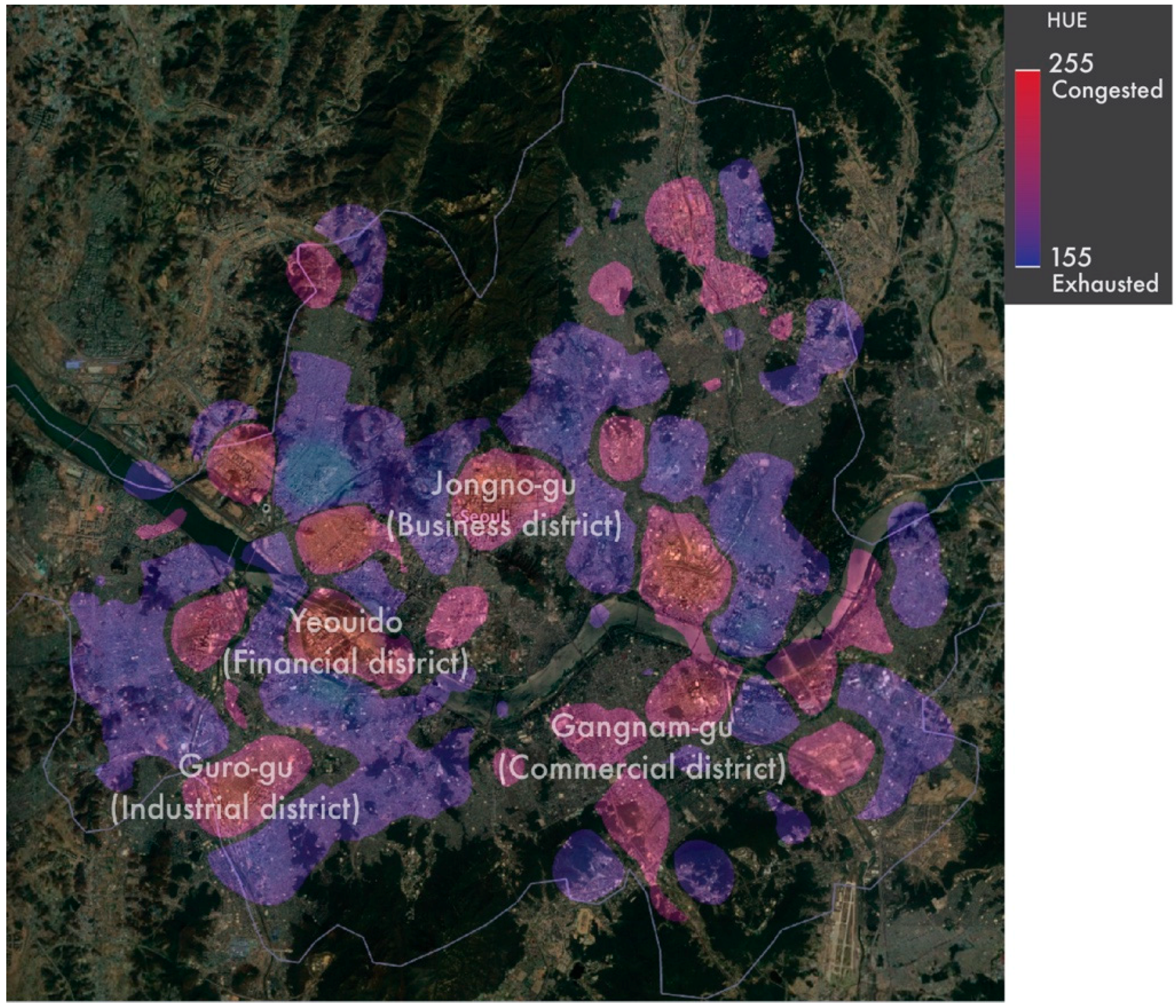
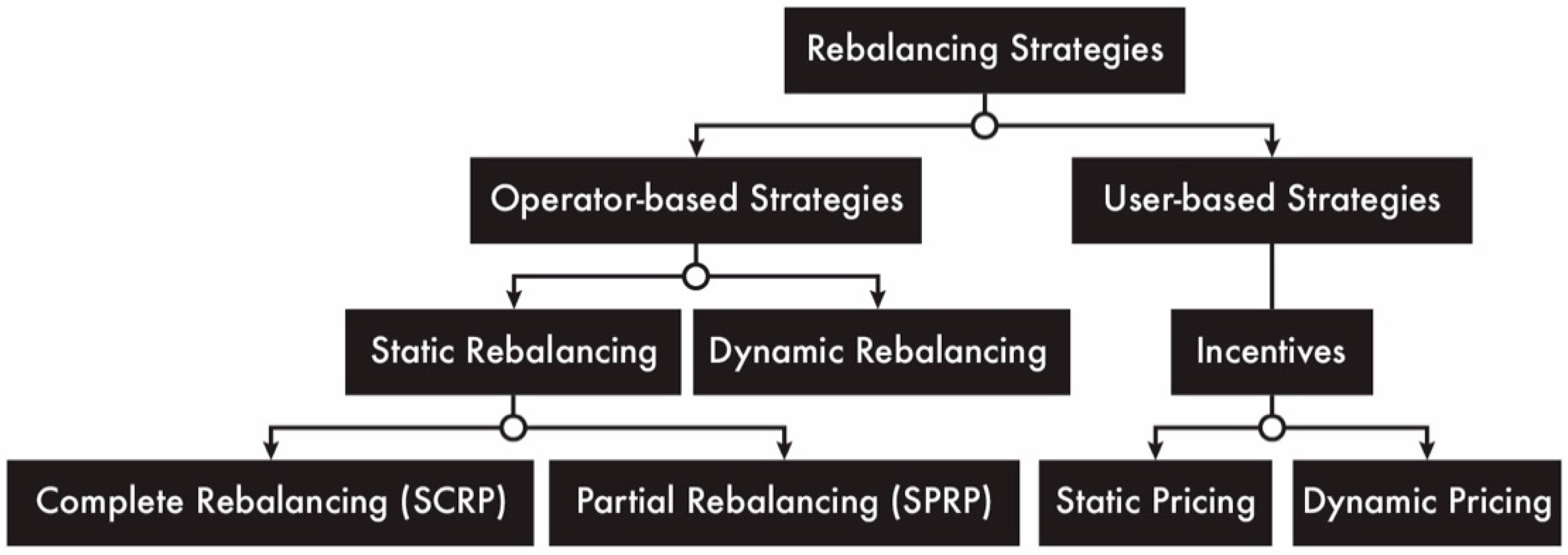
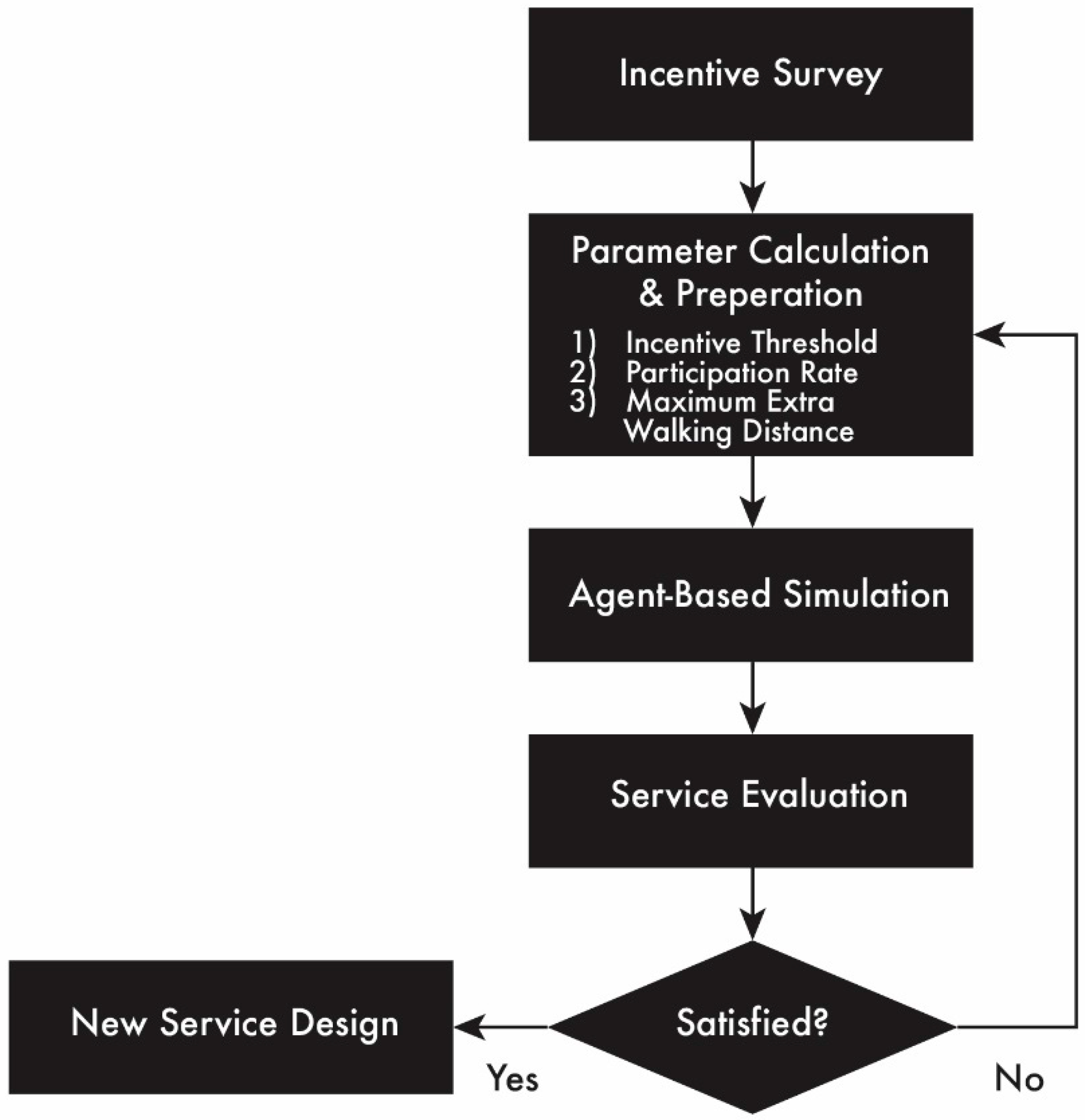
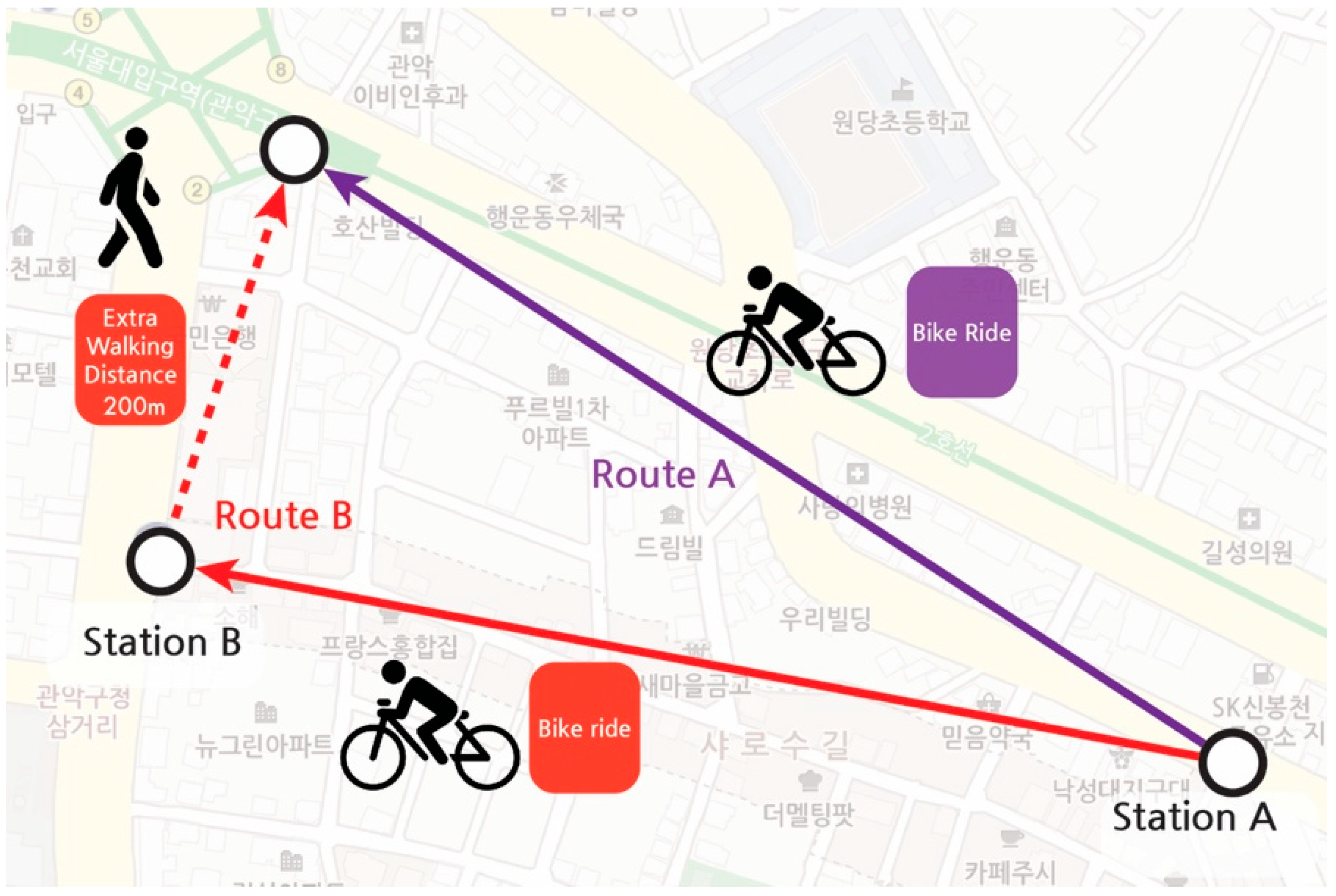
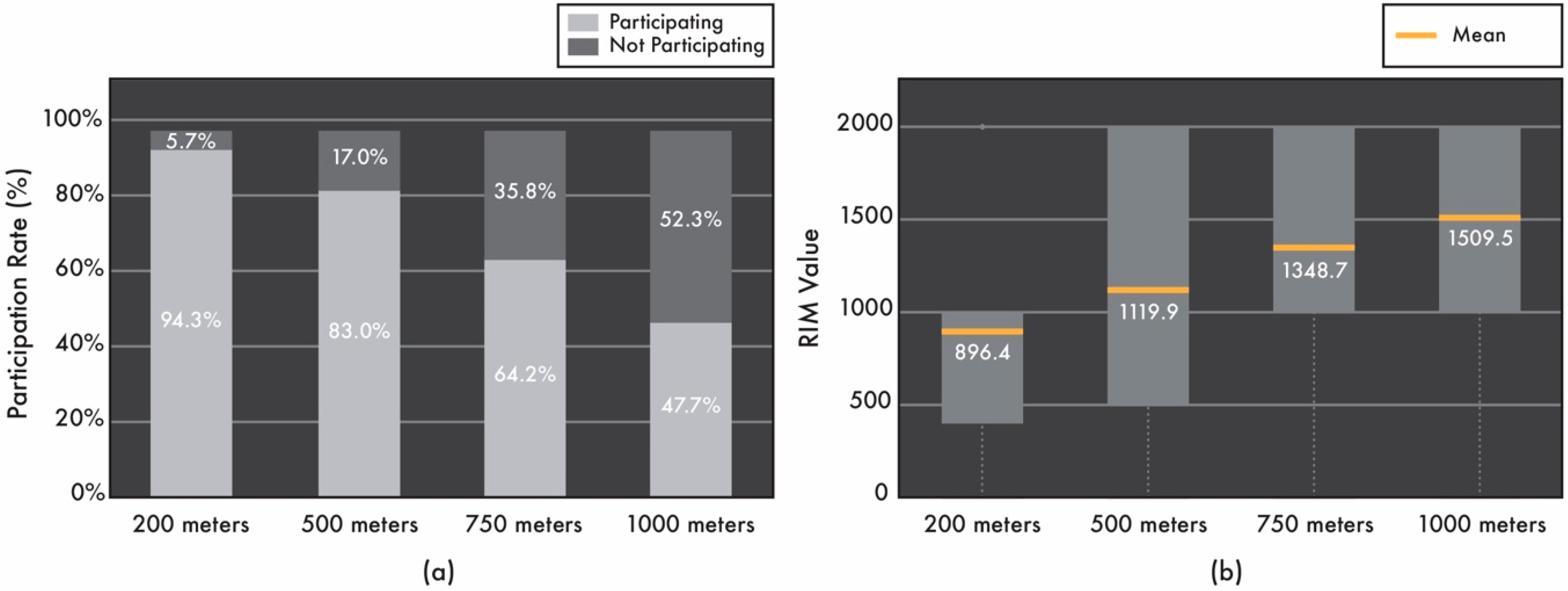
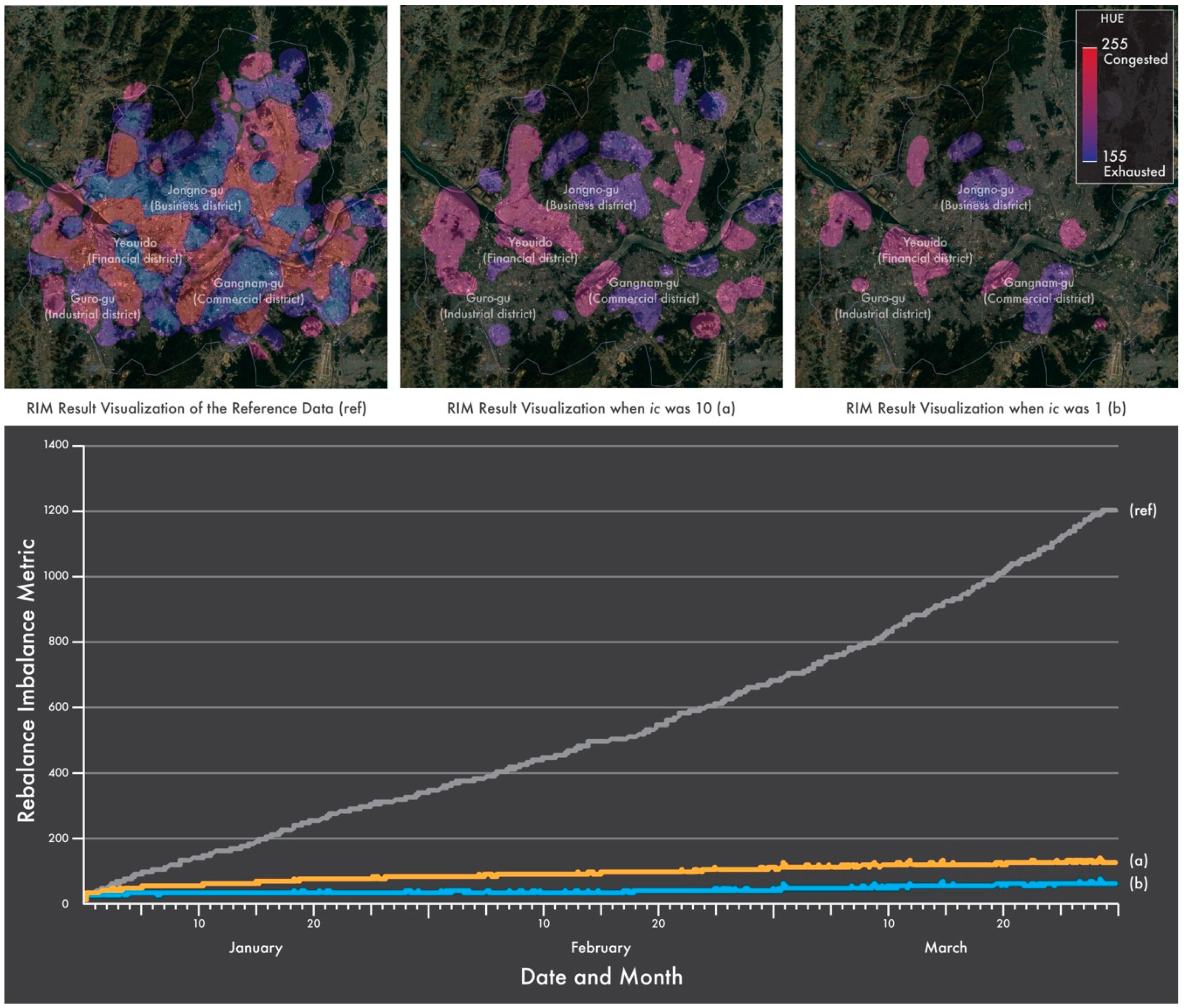
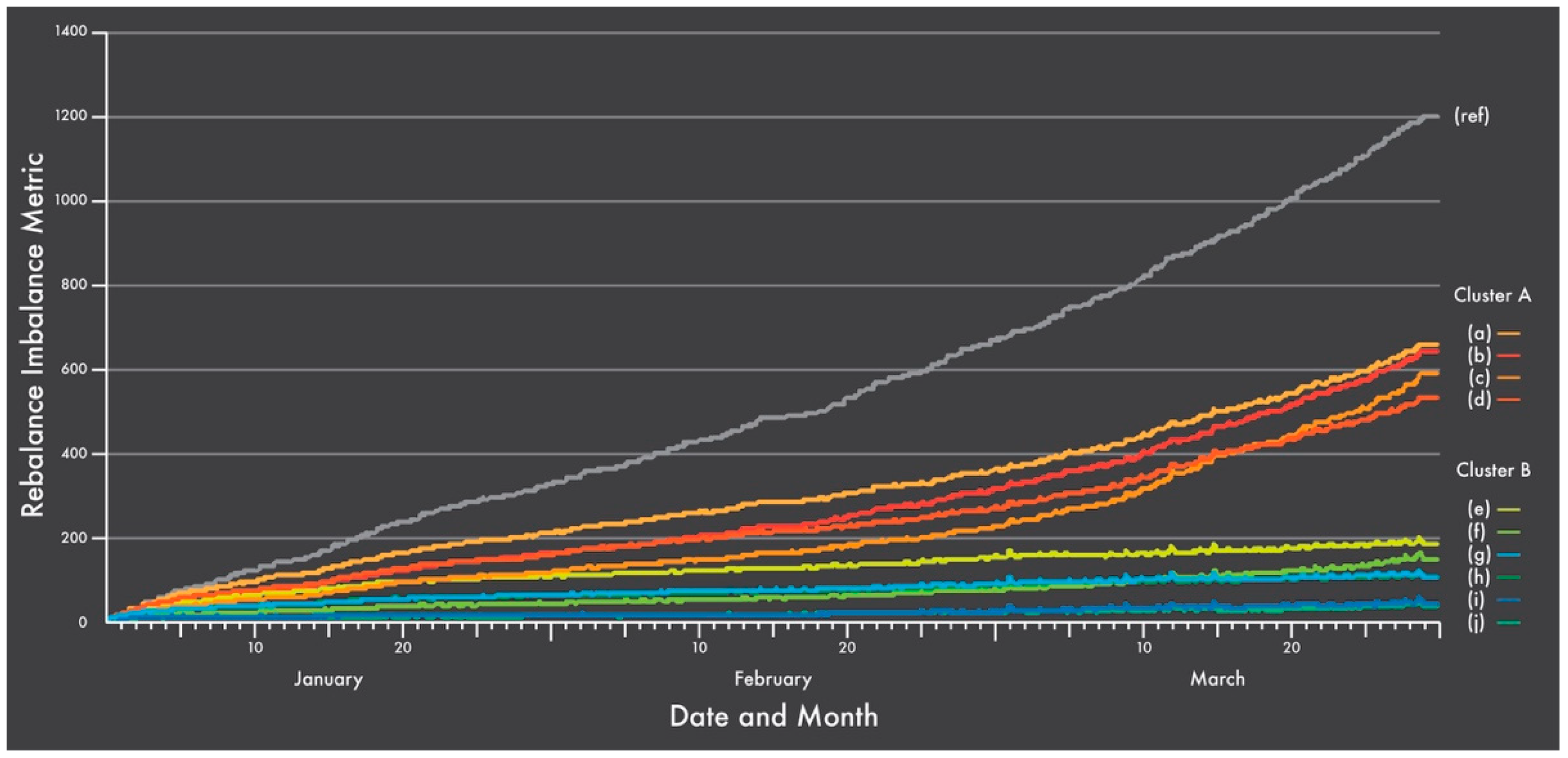
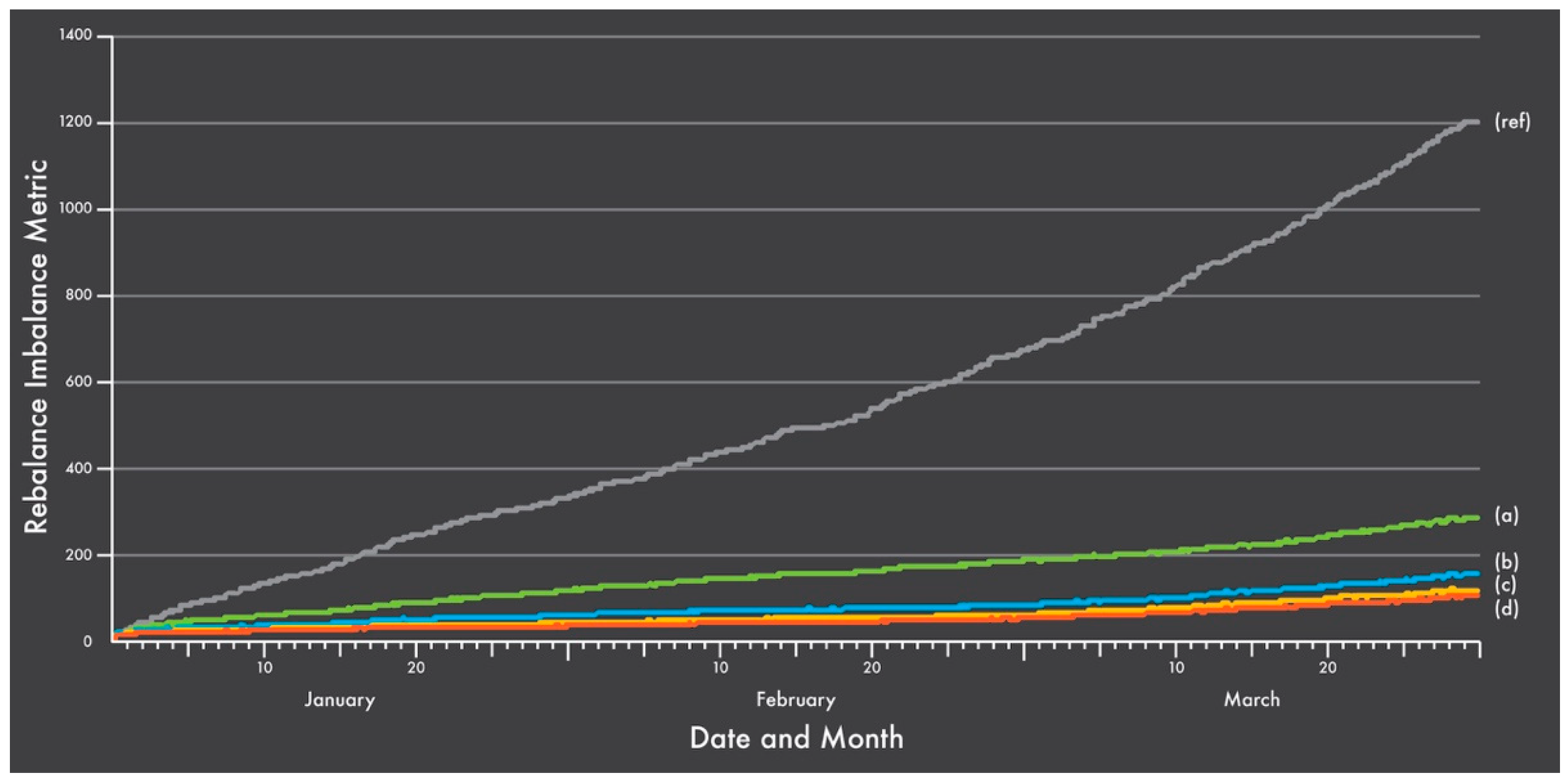
| Seoul, Korea | Copenhagen, Denmark | Amsterdam, Netherlands | Munich, Germany | Antwerp, Belgium | Helsinki, Finland | |
|---|---|---|---|---|---|---|
| Bike Usage Rate | 2.5% | 30% | 32% | 14% | 23% | 11% |
| Parameters | Notation |
|---|---|
| dRIS | Subtraction of RIS between stations |
| Wd | Extra walking distance |
| Wd_max | Maximum extra walking distance |
| ic | Incentive coefficient |
| mp | Maximum participation rate |
| Incentive threshold | ic * (Wd/Wd_max) |
| Participation rate | mp * (Wd_max- Wd)/Wd_max |
| Simulation A (ic = 1) | Simulation B (ic = 10) | Reference Data | |
|---|---|---|---|
| Average RIM | 27.3 | 78.9 | 529.6 |
| Average Travel Distance (meter) | 564.9 | 513.8 | |
| Average Incentive Payments (KRW) | 671.5 | 589.0 | |
| (0.6 USD) | (0.5) | ||
| Total Incentive Payments (KRW) | 513,820,168.8 (452,637.0 USD) | 255,188,788.3 (224,802.2 USD) | 1,284,750,000 (1,131,768.4 USD) |
| (ic = 1) | (ic = 10) | ||||
|---|---|---|---|---|---|
| Average RIM (Rebalance Imbalance Metric) | Ref | 529.6 | |||
| Wd_max | 1000 | 266.3 | 305.7 | (mp = 0.5) | |
| 212.2 | 238.7 | (mp = 1) | |||
| 2000 | 70.4 | 128.5 | (mp = 0.5) | ||
| 24.9 | 77.6 | (mp = 1) | |||
| Survey based | 27.3 | 78.9 | |||
| Average Travel Distance (meter) | Wd_max | 1000 | 454.8 | 445.2 | (mp = 0.5) |
| 452.9 | 442.6 | (mp = 1) | |||
| 2000 | 626.3 | 559.1 | (mp = 0.5) | ||
| 584.5 | 524.2 | (mp = 1) | |||
| Survey based | 564.9 | 513.8 | |||
| Average Incentive Payments (USD) | Wd_max | 1000 | 0.9 | 0.9 | (mp = 0.5) |
| 0.9 | 0.9 | (mp = 1) | |||
| 2000 | 0.6 | 0.5 | (mp = 0.5) | ||
| 0.6 | 0.5 | (mp = 1) | |||
| Survey based | 0.6 | 0.5 | |||
| Total Incentive Payments (USD) | Wd_max | 1000 | 176.5 k (15.6%) | 137.1 k (12.1%) | (mp = 0.5) |
| 333.9 k (29.5%) | 220.2 k (19.4%) | (mp = 1) | |||
| 2000 | 209.2 k (18.5%) | 113.6 k (11.8%) | (mp = 0.5) | ||
| 419.8 k (37.1%) | 211.0 k (18.6%) | (mp = 1) | |||
| Survey based | 453.1 k (40.0%) | 225.1 k (19.9%) | |||
© 2019 by the authors. Licensee MDPI, Basel, Switzerland. This article is an open access article distributed under the terms and conditions of the Creative Commons Attribution (CC BY) license (http://creativecommons.org/licenses/by/4.0/).
Share and Cite
Ban, S.; Hyun, K.H. Designing a User Participation-Based Bike Rebalancing Service. Sustainability 2019, 11, 2396. https://doi.org/10.3390/su11082396
Ban S, Hyun KH. Designing a User Participation-Based Bike Rebalancing Service. Sustainability. 2019; 11(8):2396. https://doi.org/10.3390/su11082396
Chicago/Turabian StyleBan, Seonghoon, and Kyung Hoon Hyun. 2019. "Designing a User Participation-Based Bike Rebalancing Service" Sustainability 11, no. 8: 2396. https://doi.org/10.3390/su11082396
APA StyleBan, S., & Hyun, K. H. (2019). Designing a User Participation-Based Bike Rebalancing Service. Sustainability, 11(8), 2396. https://doi.org/10.3390/su11082396




